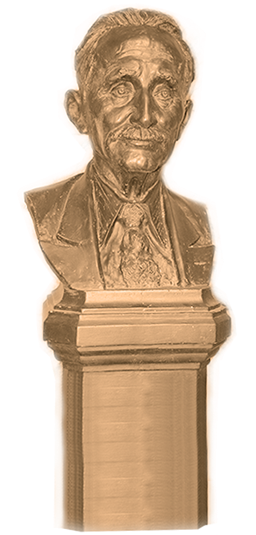
The Writer
Abdulla Shaig was also a prominent writer of fiction. His stories and short stories Məktub yetişmədi (Undelivered Letter), Köç (Encampment) and Araz are among classical samples of Azerbaijan’s XX century fiction.
Shaig is widely known as an author of romanticism. However, recent studies show that sentimentalism also had a crucial place in Shaig’s work. Both in his poetic and fiction work romanticism and sentimentalism could be observed in parallel. One of these works of the master was his novel İki müztərib, yaxud əzab və vicdan (Two Martyrs, or Suffering and Conscience), Shaig’s first work of fiction written in the form of a letter. The idea, the style and the narrative of the novel, depiction of the inner, spiritual world of its characters all correspond to characteristics of sentimentalism. The plot evolves against the backdrop of disillusionment, vulnerability and sensitivity of the characters.
During the later period, sentimentalism largely gives way to romanticism, but on some occasions it can still be seen clearly in parallel with the latter. Examples include the story of Sona in Əsrimizin qəhrəmanları (Heroes of our time), of Almaz in Araz etc. While in his later works Shaig paid close attention to broken souls and suffering hearts of the poor, he was inspired by the pureness of their inner world. This was reflected in his works Məktub yetişmədi, Köç, Əsəbi adam (Nervous Person), Dursun, Əsrimizin qəhrəmanları, Araz etc.
In Məktub yetişmədi, Əsrimizin qəhrəmanları and Araz Shaig observed the evolution of public thinking, moral evolution and destinies of representatives of various social classes.
Female characters occupied special place in Shaig’s work. Their life stories, character traits and lifestyle differed, but they had an invisible connection with each other, some of them even continuing the life path of characters from Shaig’s previous works.
Shaig’s Qoçpolad (Gochpolad), İki familiyanın məhvi (Destruction of Two Surnames), Köç (Encampment), Dursun depicted historical and ethno-cultural processes of the vast historical period encompassing the end of XIX – beginning of XX century. One can witness the attachment of the author to national, ethnic, cultural and moral traditions of Azerbaijani people. He wanted to see in his contemporaries the remarkable traits and qualities of his ancestors, such as heroism, courage, and honesty and he tried to cultivate these qualities in his reader audience using various literature techniques.
Shaig’s literary and academic heritage constitutes an invaluable part of the history of Azerbaijani literature. Through his poetry, dramaturgy and fiction readers get acquainted with evolution and mentality of Azerbaijani people within certain historical period.
In İki familiyanın məhvi, Qoçpolad, Qafqaz çiçəyi (Flower of the Caucasus), İldırım (Lightning), and Dursun the lifestyle and thinking, the system of cultural and moral values of that time are presented against the backdrop of historical and social situation during the period of feudalism and khanates.
In Məktub yetişmədi, Köç and İki müztərib yaxud əzab və vicdan (Two Martyrs, or Suffering and Conscience) we observe sentimental depiction of the realities of life and the emotional dynamics of the sensitive nature of the author.
In Timsah ovu (Crocodile Hunt), Lovğa ovçu (Boastful Hunter) and Meşə gözətçisi (Forester) the depiction of beauty of the landscape and of caring attitude of the characters towards animals are used by Shaig to instill in his readers love and respect for nature.
In Sözün qiyməti (The Price of a Word), Usta Bəxtiyar (Bakhtiyar the Workman) and Cümənin qəzəbi (Anger of Juma) Shaig uses folkloristic motives and samples of folk wisdom whereas in Hitlerin yuxusu (Hitler’s Dream) he exposes true face of fascism and in Xasay (Khasay), Vəzifə (Position) focuses on relationship between a teacher and society, upbringing and fates of the youth.
Research materials by
Prof. Dr. Alkhan Bayramoghlu
Bu yerlərin səhərləri, axşamları mənə hər şeyi unutdururdu. Axşamlar qoyun-quzu mələşə-mələşə obaya dönərkən, səsdən qulaq tutulurdu. Xüsusən yavaş-yavaş nəfəs alan səhərlərin, axşamların qanadları ucundan yayılan sərinlik, dağ çiçəklərinin, cökə ağaclarının rayihəsi, qoruqlarda, tarlalarda biçilmiş təzə otların gözəl ətri, meşənin axşamlara, səhərlərə məxsus rütubət qoxusu, bulaqların şırıltısı, quşların ötüşməsi, quzuların mələşməsi, itlərin hürüşməsi bir-birinə qarışaraq, obaya başqa bir rəng, başqa bir şəkil verirdi. Bir saat əvvəl səssizlikdən ölgün görünən təbiət birdən-birə canlanırdı. Hər şeydə bir yenilik, bir təravət görünürdü. Bundan böyük məşğələ nə ola bilərdi?
![]()
“Köç”, 1910
Əgər Şaiq olmasaydı, “Milli qiraətimiz” yox idi. “Müntəxabat” nəşr olunmamışdı, “Ədəbiyyat” dərsliyindən məhrum idik. “Türk çələngi”ni görməmiş, “Türk ədəbiyyatı”nı eşitməmişdik. Əgər bu kitablar olmasaydı, məktəblərimiz yoxsul, müəllimlərimiz yalavac qalmışdı. Sözün qısası: onun varlığındakı əhəmiyyəti layiqilə idrak edə bilmək üçün bircə dəqiqəlik yoxluğunu düşünməli!..
Qafur Əfəndizadə Qantəmir, 1923
“Ədəbiyyatçılar nə yaparlar? – deyənlərdən “Şaiq nə yapdı!?” – soracağım.
Şaiq yazılarını adi qələmlə kağızlara yazmamış, qüdsi bir əllə qəlblərə qazmışdır.
Mikayıl Rzaquluzadə, 1923

Copyright © 2016 - 2019 - House museum of Abdulla Shaig
Sayt "IT Service" MMC tərəfindən hazırlanmışdır
Bütün hüquqları qorunur.
